I’ve written many times before about dealing with edits on a story or novel manuscript, and I don’t want to repeat myself any more than necessary. But I have just received feedback from my editor on the first book in my upcoming Celtic urban fantasy series, and I thought a return to this topic might prove helpful to some. Including me.
Earlier this year, I wrote about my expanded editorial responsibilities, and the ways in which doing more editing had made me a better writer, as well as the ways in which writing for more than twenty-five years had helped hone my editorial eye. I also mentioned that the best editors are those who help writers realize their creative visions without imposing the editors’ own, and that professional writers must learn to be open to editorial comments and to avoid defensiveness.
Neither of these things is easy to do.
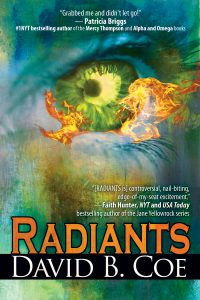 My editor at Belle Books is a woman named Debra Dixon, and she is a truly remarkable editor. This first book in the Celtic series is our third novel together, after Radiants and Invasives. In our time together, I have never once felt that her responses to my work were intrusive or unhelpful. With each book it’s been clear to me that her every observation, every criticism, every suggestion, is intended to help me tell my story with the greatest impact and in the most concise and effective prose. A writer can’t ask for more. This doesn’t mean I have agreed with every one of her comments. Now and then, I have felt strongly enough about one point or another to push back. And she’s fine with that. That’s how the editor-writer relationship is supposed to work, and she has always been crystal clear: In the end, my book is my book. But even when we have disagreed we have been clear on our shared goal: To make each book as good as it can be.
My editor at Belle Books is a woman named Debra Dixon, and she is a truly remarkable editor. This first book in the Celtic series is our third novel together, after Radiants and Invasives. In our time together, I have never once felt that her responses to my work were intrusive or unhelpful. With each book it’s been clear to me that her every observation, every criticism, every suggestion, is intended to help me tell my story with the greatest impact and in the most concise and effective prose. A writer can’t ask for more. This doesn’t mean I have agreed with every one of her comments. Now and then, I have felt strongly enough about one point or another to push back. And she’s fine with that. That’s how the editor-writer relationship is supposed to work, and she has always been crystal clear: In the end, my book is my book. But even when we have disagreed we have been clear on our shared goal: To make each book as good as it can be.
 My struggle right now is simply this: Her feedback on this first book is quite extensive and requires that I rethink some fundamental character issues and cut or change significantly several key early scenes. And she’s right about all this stuff. No doubt. This first book has been through several revisions already, and the second half of the book — really the last two-thirds of the book — just sings. I love it. She loves it. The first third is where the problems lie. To be honest, the first hundred (manuscript) pages of this book have always given me the most trouble. I wrote the initial iteration of the book more than a decade ago, and in some ways those early chapters still reflect too much the time in which they were written. They feel dated.
My struggle right now is simply this: Her feedback on this first book is quite extensive and requires that I rethink some fundamental character issues and cut or change significantly several key early scenes. And she’s right about all this stuff. No doubt. This first book has been through several revisions already, and the second half of the book — really the last two-thirds of the book — just sings. I love it. She loves it. The first third is where the problems lie. To be honest, the first hundred (manuscript) pages of this book have always given me the most trouble. I wrote the initial iteration of the book more than a decade ago, and in some ways those early chapters still reflect too much the time in which they were written. They feel dated.
So I am rethinking the opening. Again.
In the weeks to come, I will likely rewrite most or all of those early chapters. Right now I am still struggling a bit to wrap my head around how, exactly, I am going to tackle those rewrites. This is a book I love, a book I have lived with for twelve years, a book I have worked and reworked and reworked again. I thought I was done with it. I thought it would be fine as written. I needed Deb to look it over and tell me all the ways it doesn’t work.
Now that she has done this, I can’t think about the book without cringing at all the flaws I missed, that I was willing to accept. Again, to be very, very clear, I do not disagree with any of Deb’s critiques of the novel. But this doesn’t mean they don’t pain me.
And that’s all right, too. Again, as I have said many times before, writers have to be open to editorial feedback. We have to understand that our first draft, or our second, or even our tenth, isn’t perfect. A book can always be improved. We don’t publish when our books are perfect. If we did, no book would ever be published. We publish when the book is as good as we fallible humans, working together, can make it.
What I don’t always mention when writing about editing and revisions, is this: I go through a complicated emotional process when dealing with an editor’s feedback. It starts with grief. I always feel a little hurt by the criticisms of my newest baby. I feel bruised and battered, sad and even a bit helpless. We love our books. We have worked so hard to make them as wonderful as they can be. Being told they need still more work, having all their faults and flaws pointed out to us — that kind of sucks. [Editor’s note: delete “kind of”]
Grief gives way to anger pretty quickly. It’s not that this hurts, although it does. No! It’s that [insert editor’s here] is just flat-out wrong! What they hell do they know? Okay a lot. But it’s not like they’ve been doing this for years and years! Okay, yes, they have. It’s not . . . It’s not . . .
It’s not them. It’s me. And my book.
Anger sluices away, and what’s left is resignation, recognition. All those problems the editor has identified? They’re real. They need our attention.
Which brings us to despair.
My book is terrible. Despite what my editor thinks, it can’t be saved. I should just give up now.
But, of course, we have no intention of giving up. We’ve written the damn book. If we’d intended to give up, we would have done it ages ago, when we were first struggling to write it. No, the only thing we can do is fix it, make it as good as it can possibly be, which was the entire point of submitting ourselves to the editorial process in the first place. And so at last we come to acceptance.
And at that point we are ready to begin revising.
I am somewhere between despair and acceptance right now. By the time you read this, I should be fully in acceptance and ready to begin revisions.
Because I’m a professional writer, and this is what we do.
Keep writing.









 You won’t get your best ideas sitting at your desk. You’ll get them in the shower. Or, when you’re driving your car, or taking a walk on a snowy day.
You won’t get your best ideas sitting at your desk. You’ll get them in the shower. Or, when you’re driving your car, or taking a walk on a snowy day. It’s happened to all of us. It happened to me writing my new book, Demon Kissed, and the next two in The Summoner’s Mark trilogy, coming from
It’s happened to all of us. It happened to me writing my new book, Demon Kissed, and the next two in The Summoner’s Mark trilogy, coming from 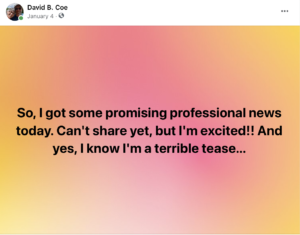 Nearly two months ago, early in the new year, I posted on social media that I had some exciting professional news I couldn’t share quite yet. I was thrilled, and wanted to let people know. But I also didn’t want to say anything before all the details had been settled. So I posted my little teaser, forgetting the one immutable rule of the publishing business: Things always happen slower than one thinks they will.
Nearly two months ago, early in the new year, I posted on social media that I had some exciting professional news I couldn’t share quite yet. I was thrilled, and wanted to let people know. But I also didn’t want to say anything before all the details had been settled. So I posted my little teaser, forgetting the one immutable rule of the publishing business: Things always happen slower than one thinks they will. For the Thieftaker novels, Tor hired the incomparable
For the Thieftaker novels, Tor hired the incomparable  The thing to remember about artwork, though, is that it’s not enough for the covers to be eye-catching. They also need to tell a story — your story. The Thieftaker covers work because they convey the time period, they offer a suggestion of the mystery contained within, and they hint as well at magic, by always including that swirl of conjuring power in Ethan’s hand. The Islevale covers all have that golden timepiece in them, the chronofor, which enables my Walkers to move through time. All my traditional epic fantasy covers, from the LonTobyn books through the Forelands and Southlands series, convey a medieval fantasy vibe. Readers who see those books, even if they don’t know me or my work, will have an immediate sense of the stories contained within.
The thing to remember about artwork, though, is that it’s not enough for the covers to be eye-catching. They also need to tell a story — your story. The Thieftaker covers work because they convey the time period, they offer a suggestion of the mystery contained within, and they hint as well at magic, by always including that swirl of conjuring power in Ethan’s hand. The Islevale covers all have that golden timepiece in them, the chronofor, which enables my Walkers to move through time. All my traditional epic fantasy covers, from the LonTobyn books through the Forelands and Southlands series, convey a medieval fantasy vibe. Readers who see those books, even if they don’t know me or my work, will have an immediate sense of the stories contained within.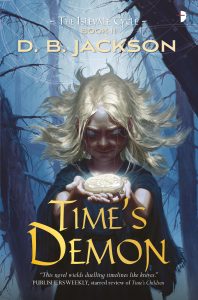 In the same vein, poor marketing practices by a publisher, even if inadvertent, can doom even the most beautiful book. I LOVE the art for Time’s Demon, the second Islevale novel. But the novel came out when the publisher was going through an intense reorganization. It got little or no marketing attention, and despite looking great and being in my view one of the best things I’ve written, it was pretty much the worst-selling book of my career.
In the same vein, poor marketing practices by a publisher, even if inadvertent, can doom even the most beautiful book. I LOVE the art for Time’s Demon, the second Islevale novel. But the novel came out when the publisher was going through an intense reorganization. It got little or no marketing attention, and despite looking great and being in my view one of the best things I’ve written, it was pretty much the worst-selling book of my career.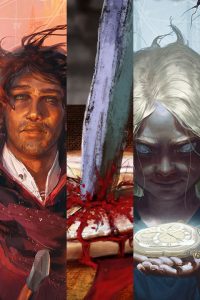 A couple of years ago, I put the finishing touches on the third book of a time travel/epic fantasy trilogy called the
A couple of years ago, I put the finishing touches on the third book of a time travel/epic fantasy trilogy called the 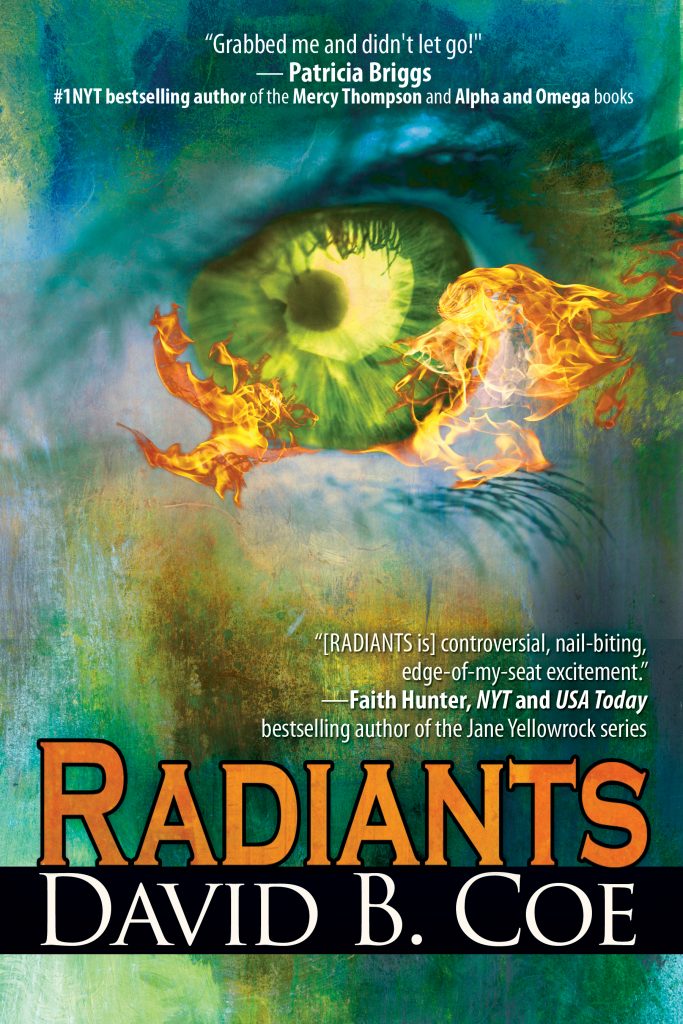 And that next book turned out to be Radiants.
And that next book turned out to be Radiants.